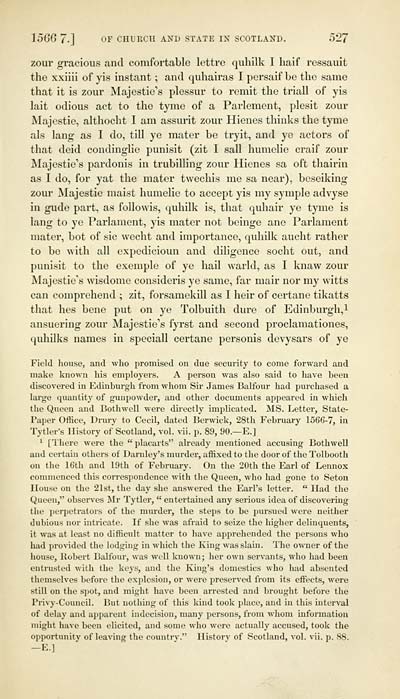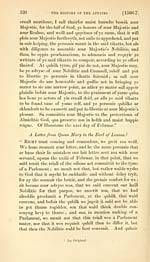Spottiswoode Society > History of the affairs of the Church and State of Scotland from the beginning of the reformation to the year 1568 > Volume 2
(551) Page 527
Download files
Complete book:
Individual page:
Thumbnail gallery: Grid view | List view

loGO 7.] OF CHDRCIl AND STATE IN SCOTLAND. 527
zour gracious and comfortable lettre quhilk I haif ressauit
the xxiiii of yis instant ; and quhairas I persaif be the same
that it is zour Majestie's plessur to remit the triall of yis
lait odious act to the tyme of a Parleraent, plesit zour
Majestic, althocht I am assurit zour Hienes thinks the tyme
als lang as I do, till ye mater be tryit, and ye actors of
that deid condinglie punisit (zit I sail humelie craif zour
Majestie's pardonis in trubilling zour Hienes sa oft thairin
as I do, for yat the mater twechis me sa near), beseiking
zour Majestic raaist humelie to accept yis my symple advyse
in gude part, as followis, quhilk is, that quhair ye tyme is
lang to ye Parlament, yis mater not beinge ane Parlament
mater, bot of sic wecht and importance, quhilk audit rather
to be with all expedicioun and diligence socht out, and
punisit to the exemple of ye hail warld, as I knaw zour
Majestie's wisdome consideris ye same, far mair nor my witts
can comprehend ; zit, forsamekill as I heir of certane tikatts
that hes bene put on ye Tolbuith dure of Edinburgh,!
ansuering zour Majestie's fyrst and second proclamationes,
quhilks names in speciall certane personis devysars of ye
Field house, and who promised on due security to come forward and
make known his employers. A jjerson was also said to have been
discovered in Edinburgh from whom Sir James Balfour had purchased a
large quantity of guuiiowder, and other documents ajjpeared in which
the Queen and Cothwell were du-ectly implicated. MS. Letter, State-
Paper Office, Drury to Cecil, dated Berwick, 28th February 1566-7, in
Tytler's History of Scotland, vol. \di. p. 89, 90.— E.]
1 [There were the " placarts" already mentioned accusing Bothwell
and certain others of Darnley's murder, affixed to the door of the Tolbooth
on the 16th and 19th of February. On the 20th the Earl of Lennox
commenced this correspondence with the Queen, who had gone to Seton
House on the 21st, the day she answered the Earl's letter. " Had the
Queen," observes Mr Tytler, " entertained any serious idea of discovering
the perpetrators of the murder, the steps to be pursued were neither
dubious nor mtricate. If she was afraid to seize the higher delinquents,
it was at least no difficult matter to have api^rehended the persons who
had pro%'ided the lodging in which the King was slain. The owner of the
house, Robert Balfour, was well known; her own servants, who had been
entnisted with the keys, and the King's domestics who had absented
themselves before the exiDlcsion, or were preserved from its effects, were
still on the spot, and might have been arrested and brought before the
Pri\^'-Council. But nothing of this kind took place, and in this interval
of delay and apparent indecision, many persons, from whom information
might have been elicited, and some who were actually accused, took the
opportunity of leaving the countrv." Historv of Scotland, vol. vii. p. 88.
-E.]
zour gracious and comfortable lettre quhilk I haif ressauit
the xxiiii of yis instant ; and quhairas I persaif be the same
that it is zour Majestie's plessur to remit the triall of yis
lait odious act to the tyme of a Parleraent, plesit zour
Majestic, althocht I am assurit zour Hienes thinks the tyme
als lang as I do, till ye mater be tryit, and ye actors of
that deid condinglie punisit (zit I sail humelie craif zour
Majestie's pardonis in trubilling zour Hienes sa oft thairin
as I do, for yat the mater twechis me sa near), beseiking
zour Majestic raaist humelie to accept yis my symple advyse
in gude part, as followis, quhilk is, that quhair ye tyme is
lang to ye Parlament, yis mater not beinge ane Parlament
mater, bot of sic wecht and importance, quhilk audit rather
to be with all expedicioun and diligence socht out, and
punisit to the exemple of ye hail warld, as I knaw zour
Majestie's wisdome consideris ye same, far mair nor my witts
can comprehend ; zit, forsamekill as I heir of certane tikatts
that hes bene put on ye Tolbuith dure of Edinburgh,!
ansuering zour Majestie's fyrst and second proclamationes,
quhilks names in speciall certane personis devysars of ye
Field house, and who promised on due security to come forward and
make known his employers. A jjerson was also said to have been
discovered in Edinburgh from whom Sir James Balfour had purchased a
large quantity of guuiiowder, and other documents ajjpeared in which
the Queen and Cothwell were du-ectly implicated. MS. Letter, State-
Paper Office, Drury to Cecil, dated Berwick, 28th February 1566-7, in
Tytler's History of Scotland, vol. \di. p. 89, 90.— E.]
1 [There were the " placarts" already mentioned accusing Bothwell
and certain others of Darnley's murder, affixed to the door of the Tolbooth
on the 16th and 19th of February. On the 20th the Earl of Lennox
commenced this correspondence with the Queen, who had gone to Seton
House on the 21st, the day she answered the Earl's letter. " Had the
Queen," observes Mr Tytler, " entertained any serious idea of discovering
the perpetrators of the murder, the steps to be pursued were neither
dubious nor mtricate. If she was afraid to seize the higher delinquents,
it was at least no difficult matter to have api^rehended the persons who
had pro%'ided the lodging in which the King was slain. The owner of the
house, Robert Balfour, was well known; her own servants, who had been
entnisted with the keys, and the King's domestics who had absented
themselves before the exiDlcsion, or were preserved from its effects, were
still on the spot, and might have been arrested and brought before the
Pri\^'-Council. But nothing of this kind took place, and in this interval
of delay and apparent indecision, many persons, from whom information
might have been elicited, and some who were actually accused, took the
opportunity of leaving the countrv." Historv of Scotland, vol. vii. p. 88.
-E.]
Set display mode to: Large image | Transcription
Images and transcriptions on this page, including medium image downloads, may be used under the Creative Commons Attribution 4.0 International Licence unless otherwise stated. ![]()
| Permanent URL | https://digital.nls.uk/79611061 |
|---|
| Description | Volume II. |
|---|---|
| Attribution and copyright: |
|

